Kunming, Yunnan
21 February 2006
For those of you counting the weeks since we last worked, the answer is seven. But illogically given the reluctance of all concerned (faculty, students and administrators), school has resumed. So rather than conscientiously plan a course of study for this semester, I’ll catch up on the blog with a series of posts beginning here with a description of our brief transit through Kunming, and finishing eventually with stories from our latest trek along and across the Yangze River north of Lijiang (the highlight of our holiday).
It’s been a great vacation and I hope all of you can be so lucky as to have the time and resources to explore a piece of the world as interesting as this. It occurred to me as I daydreamed in class today (while the students generated lists of study topics) that Asia is a cultural and geographic fractal—at every level of detail one finds something interesting to explore. From the striking differences between Thai and Chinese society and culture, to contrasts between Chinese provinces, to the diversity of ethnic regions within the Yunnan Province, to a closer focus on villages, families, and individuals and the surprise of finding a deliberate splash of bright blue paint on a brown adobe wall, there is something interesting wherever you look.
Kunming, the thriving capitol of Yunnan, was our travel hub for the first month of the holiday. Ellen flew through Kunming on her way to the U.S. (where she spent a busy week). Bei and I flew through Kunming on our way to Bangkok. All three of us jetted in and out of Kunming on our return from Thailand, our trip to Xishuangbana and back, and finally, on our dash north to Lijiang to stage for our final weeks of mountain treks.
All to say, if you need something to eat, don’t go to the airport in Kunming.
I don’t have a lot to say about Kunming except the following:
1. For a medium sized Chinese city, it’s not a bad place to spend some time.
2. Although called “the spring city” for its year-round climate, in January don’t be surprised to find locals huddled around burning bits of plywood and trash, trying to stay warm beneath leaden gray skies.
3. There are restaurants in Kunming that know how to make bread.
4. Try not to make your plane reservations at the airport.
5. Don’t go to the zoo.
6. You can buy Kraft Macaroni and Cheese (the cheesiest!) at Paul’s Store near Yunnan University.
7. The bread tastes great after months of Chinese “bread.”
8. Get some of the bread and eat it.
Here are some photos:
While Ellen was in the U.S. (Denver, Boulder and Laramie), Bei and I spent a day in Kunming on our way to Thailand. Our first order of business was to visit the Bamboo Temple (Qiongzhu Si), famous for elaborate statues of Buddhas surfing big breaking waves on "surfboards" including all manner of sea and land creatures. The Tang Dynasty temple was burned and rebuilt in the 15th century and then restored in the late 1800s at which time the Buddha sculptures and sculptures of 500 stylized nobles were created by a Sichuanese sculptor named Li Guangxiu along with his helpers (all of the above historical information is from the Lonely Planet China guidebook and is not my own research!). The sculptures are amazing but photos are prohibited. This Buddha statue is not part of that collection. Note the swastika, a common symbol used in Buddhism and elsewhere. It does not mean that the Buddha is a skinhead, but rather symbolizes plurality, eternity, abundance, prosperity and long life. It's hard to shake our more modern reaction to the symbol, but one sees it everywhere in the Buddhist world (and associated with other Eastern religions).
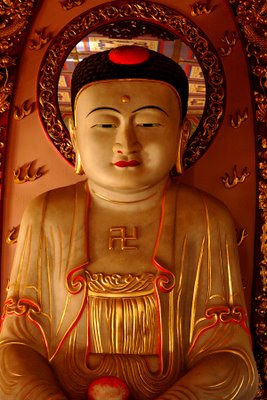
Incense sticks offered at the Bamboo temple.

Bei scans for approaching visitors in a stairwell at the Bamboo Temple. We were quietly exploring areas that we weren't sure we were allowed to visit. Bei's job was to occupy the authorities with small talk about Barbies and princesses while I made my escape.
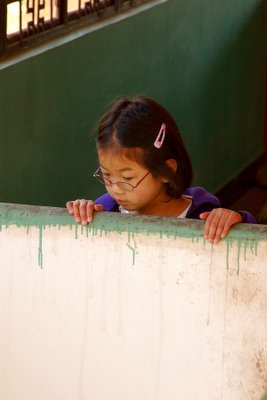
A truckload of stone supports for wooden pillars which are also used as stools around stone picnic tables. The monastary was undergoing some renovation and these were awaiting placement.

Stone steps in the lush forest behind the temple.

Bei posing in a storage area for stone paraphernalia.

Slates slated for use in the temple restoration collect moss and leaves behind the temple.
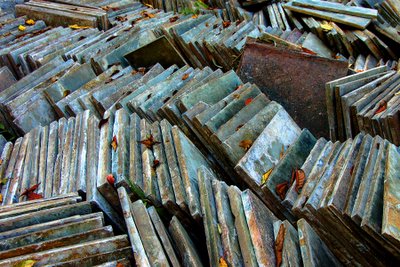
A chalkboard in a back room of the bamboo temple.

The same chalkboard and a cooking pot. It's important to be able to cook while one writes on the board, and I for one am hoping to get stoves installed in the classrooms here at the college so that I can fry pork while I teach English.

Bei on her way to a Buddhist public bathroom. She made it in time.
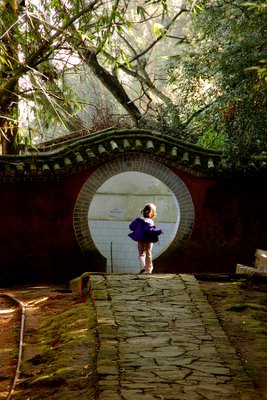
You've seen this before--the photo of Alan Greenspan caught my eye both because of his retirement and because the familiar power figure of American capitalism seemed oddly out of place as a window covering at a Chinese Buddhist temple. I assume he is still in place, fading in the sun.
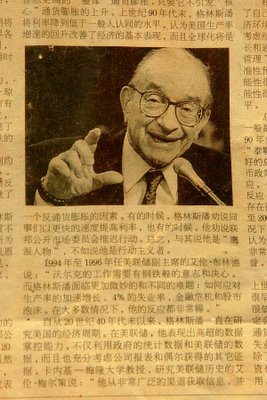
Who holds the most gold--this Buddha or Alan Greenspan? I suspect the two shall never meet.
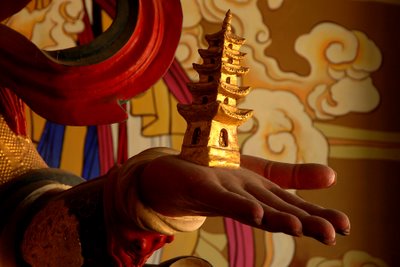
Back in the city of Kunming, this boldly painted house stood out among more traditional architecture.

A carrot seller on his way to market in downtown Kunming.
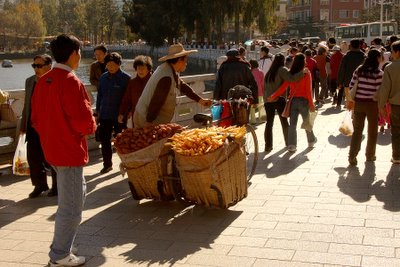
You've seen this photo as well. Downtown Kunming is a thriving shopping zone and salespeople were commonly seen lined up like this, apparently receiving pep talks for the day's retailing. The number of cell phone stores in China is especially remarkable -- although these salespeople were outside a general department store, entire city blocks are devoted to cell phones.
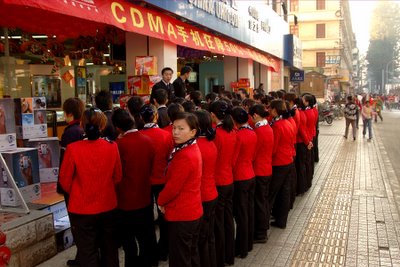
A man in an alley enjoys a little sun while watching a card game. I suspect he also plays blues harmonica. Or saxophone.

Along with this woman. Note the poker face. I think she's a card counter.

For those of you counting the weeks since we last worked, the answer is seven. But illogically given the reluctance of all concerned (faculty, students and administrators), school has resumed. So rather than conscientiously plan a course of study for this semester, I’ll catch up on the blog with a series of posts beginning here with a description of our brief transit through Kunming, and finishing eventually with stories from our latest trek along and across the Yangze River north of Lijiang (the highlight of our holiday).
It’s been a great vacation and I hope all of you can be so lucky as to have the time and resources to explore a piece of the world as interesting as this. It occurred to me as I daydreamed in class today (while the students generated lists of study topics) that Asia is a cultural and geographic fractal—at every level of detail one finds something interesting to explore. From the striking differences between Thai and Chinese society and culture, to contrasts between Chinese provinces, to the diversity of ethnic regions within the Yunnan Province, to a closer focus on villages, families, and individuals and the surprise of finding a deliberate splash of bright blue paint on a brown adobe wall, there is something interesting wherever you look.
Kunming, the thriving capitol of Yunnan, was our travel hub for the first month of the holiday. Ellen flew through Kunming on her way to the U.S. (where she spent a busy week). Bei and I flew through Kunming on our way to Bangkok. All three of us jetted in and out of Kunming on our return from Thailand, our trip to Xishuangbana and back, and finally, on our dash north to Lijiang to stage for our final weeks of mountain treks.
All to say, if you need something to eat, don’t go to the airport in Kunming.
I don’t have a lot to say about Kunming except the following:
1. For a medium sized Chinese city, it’s not a bad place to spend some time.
2. Although called “the spring city” for its year-round climate, in January don’t be surprised to find locals huddled around burning bits of plywood and trash, trying to stay warm beneath leaden gray skies.
3. There are restaurants in Kunming that know how to make bread.
4. Try not to make your plane reservations at the airport.
5. Don’t go to the zoo.
6. You can buy Kraft Macaroni and Cheese (the cheesiest!) at Paul’s Store near Yunnan University.
7. The bread tastes great after months of Chinese “bread.”
8. Get some of the bread and eat it.
Here are some photos:
While Ellen was in the U.S. (Denver, Boulder and Laramie), Bei and I spent a day in Kunming on our way to Thailand. Our first order of business was to visit the Bamboo Temple (Qiongzhu Si), famous for elaborate statues of Buddhas surfing big breaking waves on "surfboards" including all manner of sea and land creatures. The Tang Dynasty temple was burned and rebuilt in the 15th century and then restored in the late 1800s at which time the Buddha sculptures and sculptures of 500 stylized nobles were created by a Sichuanese sculptor named Li Guangxiu along with his helpers (all of the above historical information is from the Lonely Planet China guidebook and is not my own research!). The sculptures are amazing but photos are prohibited. This Buddha statue is not part of that collection. Note the swastika, a common symbol used in Buddhism and elsewhere. It does not mean that the Buddha is a skinhead, but rather symbolizes plurality, eternity, abundance, prosperity and long life. It's hard to shake our more modern reaction to the symbol, but one sees it everywhere in the Buddhist world (and associated with other Eastern religions).

Incense sticks offered at the Bamboo temple.

Bei scans for approaching visitors in a stairwell at the Bamboo Temple. We were quietly exploring areas that we weren't sure we were allowed to visit. Bei's job was to occupy the authorities with small talk about Barbies and princesses while I made my escape.

A truckload of stone supports for wooden pillars which are also used as stools around stone picnic tables. The monastary was undergoing some renovation and these were awaiting placement.

Stone steps in the lush forest behind the temple.

Bei posing in a storage area for stone paraphernalia.

Slates slated for use in the temple restoration collect moss and leaves behind the temple.

A chalkboard in a back room of the bamboo temple.

The same chalkboard and a cooking pot. It's important to be able to cook while one writes on the board, and I for one am hoping to get stoves installed in the classrooms here at the college so that I can fry pork while I teach English.

Bei on her way to a Buddhist public bathroom. She made it in time.

You've seen this before--the photo of Alan Greenspan caught my eye both because of his retirement and because the familiar power figure of American capitalism seemed oddly out of place as a window covering at a Chinese Buddhist temple. I assume he is still in place, fading in the sun.

Who holds the most gold--this Buddha or Alan Greenspan? I suspect the two shall never meet.

Back in the city of Kunming, this boldly painted house stood out among more traditional architecture.

A carrot seller on his way to market in downtown Kunming.

You've seen this photo as well. Downtown Kunming is a thriving shopping zone and salespeople were commonly seen lined up like this, apparently receiving pep talks for the day's retailing. The number of cell phone stores in China is especially remarkable -- although these salespeople were outside a general department store, entire city blocks are devoted to cell phones.

A man in an alley enjoys a little sun while watching a card game. I suspect he also plays blues harmonica. Or saxophone.

Along with this woman. Note the poker face. I think she's a card counter.


0 Comments:
Post a Comment
<< Home